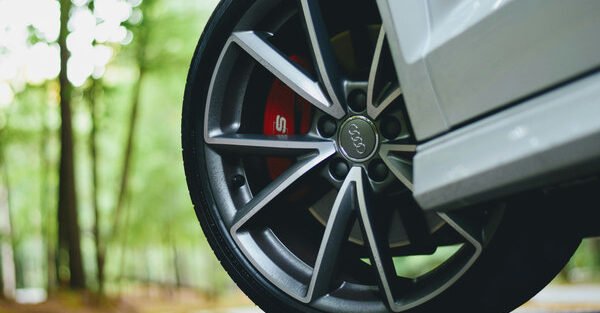Why is it dangerous to drive on flat tyres?
Maintaining optimum internal tyre pressure is one of the most important elements of car tyre care. If the pressure level inside the tyre is optimal, it ensures even contact between the tread and the road surface and protects the tyre from premature failure. If the pressure level is below the normal range, this can lead to negative consequences, up to and including an accident, as the pressure level directly affects the vehicle’s handling and therefore the driver’s safety.
What should the tyre pressure level be?
Everything is very simple here. The manufacturer sets a recommended figure for each vehicle, and you should stick to it. You can find the information, as a rule, in the car’s owner’s manual. Some manufacturers put a notice on the petrol filler flap or on the driver’s side of the centre pillar of the body. The information can also be printed on the sidewall of the tyre.
Of course, the manufacturer may also allow the use of different tyre sizes, for which the recommended pressure will be different. In addition, sometimes the pressure level can be different even for the front and rear tyres. You should take all this into account and read the vehicle manufacturer’s recommendations carefully.
Ambient temperature has a direct impact on tyre pressure. Not many people know, but in a closed space, the air pressure drops by around 0.1 bar for every 10°C drop in temperature. This also affects the operation of car tyres.
For example, if you put summer tyres on your car in April, you don’t have to worry that the pressure inside will drop under the influence of the environment until the end of August, when it gradually starts to get colder. Therefore, it is always recommended to check the pressure level at the end of summer and inflate the tyres if necessary.
In the cold season, you need to check more often. In particular, after the winter tyres have been fitted around the end of October, it is recommended to check the pressure level at the first frost. It’s also a good idea to check it again when the temperature drops to minus 10 and then minus 20°C.
What are the consequences of driving on underinflated wheels?
Using tyres with a reduced pressure level can be very dangerous. Much of this, of course, depends on the degree of discrepancy with the recommended value. And of course, the greater the difference, the more dangerous it will be to drive such a car. Even an underinflation of just 0.3 atmospheres can have a serious negative impact on the vital characteristics of the vehicle. Let’s take a closer look at what the consequences are. Every driver should know this!
Reduced handling
First of all, a car with flat tyres loses its main dynamic characteristics and may experience difficulties with steering. The car accelerates worse and the steering wheel may not respond. Reduced pressure also makes it harder for the driver to take corners at speed. During the manoeuvre, the car loses control, becomes unstable, and does not hold its trajectory well – all of which can lead to an uncontrolled skid. Also, when driving in the rain or on wet roads, the wheels can behave very unpredictably, which also increases the risk of an accident.
Braking problems
One of the most dangerous consequences is a reduction in braking performance. In the event of an emergency stop, there is a significant increase in stopping distance. This is especially noticeable on icy road surfaces in winter and on wet roads. And it’s not just a small increase in stopping distance, which has little effect. When driving at high speeds on the highway, even a very small discrepancy between the parameter and the recommended norm can cause big problems and often leads to the most unpredictable consequences. For example, reduced pressure increases the likelihood of a tyre burst.
Increased wear and tear
If you drive on flat tyres for a long time, you should prepare for the fact that you will have to change them frequently. This is because flat tyres wear out very quickly. Experts say that if the tyre pressure is 20% below normal, their service life is reduced by 30% on average. In particular, during operation, irreversible damage to the carcass can occur around the entire circumference of the sidewalls. Tyres lose their shape, overheat and deform. Then the cord delaminates and breaks. Therefore, it is extremely dangerous to drive on underinflated tyres on bad roads. This increases the risk of an accident if the tyre bursts at high speed.
Increased fuel consumption
This is perhaps a consequence that is not dangerous, but is also quite unpleasant. Experts confirm that when driving a car with the wheels down, even with a slight loss of pressure, petrol consumption increases significantly. And this can hit the car owner’s pocket hard.
How often do I check the tyre pressure?
You should check the pressure in your car tyres regularly because, as we have already mentioned, this indicator can change during the operation of the vehicle and is subject to seasonal fluctuations due to changes in air temperature. Even when used in ideal conditions, tyres can lose pressure. The average rate of loss is about 0.069 bar per month. That is why it is recommended to check this indicator on a monthly basis.
A special device called a tyre pressure gauge is used to determine the tyre pressure. This small device is very easy to use. However, when checking, you should follow some recommendations. In particular, the pressure should be checked only when the tyres are cold. This is due to the fact that when driving, the tyres warm up, which leads to inaccuracies in the measurement. The best time to measure the pressure level is in the morning before the car leaves the garage.


